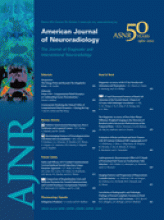We thank Dr Xu and colleagues for their response to our article entitled “Stent Placement from the Vertebral Artery to the Posterior Inferior Cerebellar Artery” and would hereby like to respond to some of their worthwhile discussion points.
In our country, available self-expandable intracranial stents are the Enterprise (Codman Neurovascular, Miami Lakes, Florida), Neuroform (Stryker Neurovascular, Natick, Massachusetts), Solitaire (ev3, Irvine, California), and Wingspan (Boston Scientific, Fremont, California). Stent-assisted coil embolization for preservation of the parent artery with intracranial aneurysms is becoming increasingly widespread and relies on mainly 2 types of self-expandable intracranial stents: the open-cell-type Neuroform and the closed-cell-type Enterprise.1
The Neuroform stent was the first self-expandable intracranial stent.2,3 However, the first-generation Neuroform stent had drawbacks of difficulty and instability with stent delivery. The second-generation Neuroform2 stent also had potential sources of complications due to distal wire injury, though it overcame the previous drawbacks by using a 3F microdelivery catheter and a 2F stabilizer catheter. Recently, the advanced Neuroform EZ 3 has been introduced, but it needs a microcatheter with a 0.027-inch inner diameter, larger than that needed by the Enterprise stent with a 0.021-inch inner diameter.
The intra-/extra-aneurysmal Neuroform stent placement to protect the posterior inferior cerebellar artery (PICA) for selected cases can also be considered another option as Dr Xu suggested. Because of its open-cell design, the distal aspect of the stent within the aneurysm fundus acts to capture and restrain the initial coils, holding them within the aneurysm and allowing neck reconstruction.
However, the Enterprise stent is more maneuverable than the Neuroform stent in our experience. Some authors reported that kinking and flattening of the Enterprise body can occur in curved vessels due to the closed-cell design, and the dislodgment might influence insufficient coil packing and obliteration of parent artery.4⇓–6 However, in our study, the ability of the Enterprise stent to capture coils in aneurysms was excellent and flow of the parent artery was patent without stenosis or occlusion. The Enterprise stent has higher radial force and bending stiffness than the Neuroform stent.5 The characteristics of the Enterprise stent may be paradoxic effectiveness for better flow of the PICA.7 Indeed, the caliber of the PICA increased and the angle of the vertebral artery–PICA junction became larger after the procedure in most of our cases.
The above 2 stents may be available as supporting materials for smaller vessels such as the PICA. For the clinical practitioner, the more experienced or favorable “weapon” may be the most effective and safe for the goal of treatment.
References
- © 2012 by American Journal of Neuroradiology











